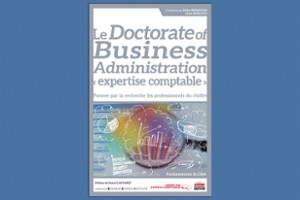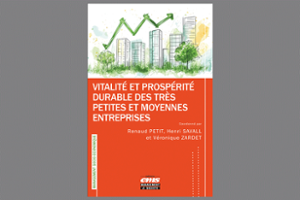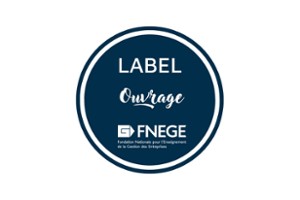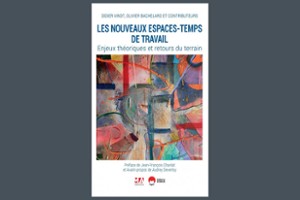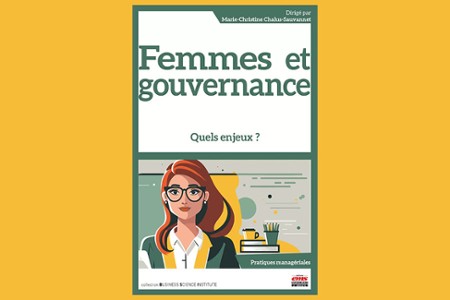Dans la même rubrique
Accueil :
- Accueil FR
- Publications
Publications
Publications
► Voir tout
- [hal-04118678] Analyzing the use of videoconference by and for older adults in nursing homes: an interdisciplinary approach to learn from the pandemic3 décembre 2024Introduction: During the Covid-19 pandemic and the resulting visitation restrictions, digital tools were used in many nursing homes in France to allow the older adults and their relatives to maintain social contact via videoconferencing. This article adopts an interdisciplinary approach to analyze the processes that affect the use of digital technologies. Methods: Drawing on the concept of “mediation,” it seeks to shed light on how individuals embrace these tools in a relational situation. The interviews and observations undertaken among residents, their relatives, professionals, and the management head of seven nursing homes in 2021, make it possible to outline the different forms of practices and uses and to identify the factors leading to the variations observed. Results: While the key objective of these technical and technological tools is to compensate – on a functional level – for the communication problems and the isolation of individuals in order to promote residents’ “quality of life” by maintaining “social contact,” our study reveals that these tools’ uses and practices largely differ. It also shows considerable inequalities in terms of residents’ acquisition of subjective feelings of ownership of the tools. These are never attributed to isolated physical, cognitive, psychic, and social difficulties, but are influenced by specific organizational, interactional, and psychic configurations. Some of the structures analyzed revealed situations in which mediation failed, occasionally exposing the risk associated with seeking “ties at all costs,” or revealing a disturbing strangeness when residents were placed in front of screens. Some configurations, however, showed that it was possible to set up an intermediate space for the experience to unfold, which in turn opened up a space where individuals, groups, and institutions could experiment, allowing them to develop subjective feelings of ownership of this experience. Discussion: This article discusses how the configurations that failed to promote the mediation process reveal the need to assess the representations of care and assistance in the relationships between older adults, their loved ones, and nursing home professionals. Indeed, in certain situations, the use of videoconferencing, while seeking to produce a positive effect, risks displacing and increasing the effects of the “negative” associated with dependency, which may worsen individuals’ difficulties within nursing homes. The risks associated with the failure to take into account residents’ requests and consent explain why it is important to discuss how certain uses of digital tools may renew the dilemma between concerns for protection, on the one hand, and respect for autonomy on the other.
- [hal-01907980] Riding the Roller-Coaster of the Accreditation Process at Higher Education Institutions through Employees Engagement19 décembre 2018At the present time, Higher Education Institutions (HEI) are increasingly engaging in the accreditation process. The complexity of the accreditation process imposes on HEIs the urgent need to maintain sustainability. The pertinent literature reveals that employee engagement is an enduring praxis that helps organizations to gain sustainability and resolve organizational challenges such as the lack of cohesion so often observed in academic communities. This paper describes how a private University in the Gulf region, through promoting job autonomy and inciting engagement among its administrative staff and faculty members, has tried to successfully maneuver beyond and rode the accreditation roller-coaster.
- [hal-04221984] Décider dans la tourmente : quatre CHU face à la Covid-1928 septembre 2023L’objectif de cet article [1] est double : mieux comprendre le processus organisationnel de prise de décision mobilisé par les hôpitaux durant la première année de la pandémie afin de faire face à cette crise ; et vérifier dans quelle mesure ce processus s’apparente à celui déployé par les organisations à haute fiabilité (OHF). Les résultats de la recherche exploratoire réalisée au sein de quatre centres hospitaliers universitaires (CHU) montre que le processus de prise de décision se manifeste différemment au cours de trois périodes successives : au début de l’apparition de la Covid-19 dans notre pays, le processus est celui d’une bureaucratie weberienne ; au cours de la première vague jusqu’à sa fin il devient flexible, agile ; et enfin, à partir de la deuxième vague, il reprend son caractère bureaucratique initial. La dernière partie met en avant les apports de la théorie des OHF aux sciences de gestion et au pilotage des hôpitaux français.
- [hal-04272953] La Pensée Complexe pour interroger les pratiques organisationnelles dans quatre CHU français durant les deux premières vagues de la crise Covid7 novembre 2023Malgré sa large diffusion en France et dans le monde, en particulier depuis le début de la crise sanitaire, la pensée complexe (PC) définie par Edgar Morin demeure peu utilisée pour comprendre le fonctionnement des organisations. C’est pourquoi cet article interroge la pertinence de l’utilisation de la PC dans un contexte de forte incertitude, en particulier l’apparition de la pandémie de Covid-19, en France en 2020. Une recherche exploratoire qualitative conduite auprès de quatre hôpitaux montre une adéquation forte entre les pratiques professionnelles et les principes de la PC lors de la première vague du virus, suivie d’une inadéquation flagrante à partir de la deuxième vague. La discussion montre l’intérêt de la PC pour les sciences de gestion, mais également pour les managers à qui elle offre un cadre épistémologique propice à l’appréhension de l’incertitude. L’opérationnalisation de la PC suggère une gestion de crise non plus seulement réalisée à partir de règles préalablement définies, mais enrichie d’une vision constructiviste dans un objectif de transformation positive des organisations hospitalières, traversées de tensions multiples qui dépassent désormais le seul cadre de la crise de la Covid-19.
- [hal-03632783] Institutional duality incidence on subsidiaries: configuration, differentiation and avoidance strategies12 avril 2022Purpose To illustrate how threats of institutional duality (ID) incidence subsidiaries confront are converted to opportunities, by conceptualizing how subsidiaries attain operational legitimacy at both their headquarters (HQs) and host countries. Design/methodology/approach Using a systematic literature review, the authors build on institutional theories by analyzing the ID literature along its structure, main processes and outcomes. The authors configure frameworks of both HQ control systems and host countries' institutional threats, showing how subsidiaries contingently navigate across them using configuration, differentiation and avoidance strategies. Findings The authors’ findings show that “foresighted” subsidiaries attain operational legitimacy through configuration, differentiation and avoidance of threats incidental to ID, by strategizing along certain formal and informal institutional variables including legal, sociocultural and technical factors. Originality/value The authors propose “structural configuration of ID incidence” and “subsidiary path to legitimacy” frameworks. The former configures how the interaction between HQ and host countries' variables constitute ID incidence threats. The latter highlights how “foresighted” subsidiaries use configuration, differentiation and avoidance strategies to attain operational legitimacy.
- [hal-01669916] Comparison of Clinical Presentations and Outcomes Between Patients With TGFBR2 and FBN1 Mutations in Marfan Syndrome and Related Disorders21 décembre 2017mutations were recognized recently among patients with a Marfan-like phenotype. The associated clinical and prognostic spectra remain unclear. Methods and Results—Clinical features and outcomes of 71 patients with a TGFBR2 mutation (TGFBR2 group) were compared with 50 age-and sex-matched unaffected family members (control subjects) and 243 patients harboring FBN1 mutations (FBN1 group). Aortic dilatation was present in a similar proportion of patients in both the TGFBR2 and FBN1 groups (78% versus 79%, respectively) but was highly variable. The incidence and average age for thoracic aortic surgery (31% versus 27% and 3516 versus 3913 years, respectively) and aortic dissection (14% versus 10% and 3812 versus 399 years) were also similar in the 2 groups. Mitral valve involvement (myxomatous, prolapse, mitral regurgitation) was less frequent in the TGFBR2 than in the FBN1 group (all P0.05). Aortic dilatation, dissection, or sudden death was the index event leading to genetic diagnosis in 65% of families with TGFBR2 mutations, versus 32% with FBN1 mutations (P0.002). The rate of death was greater in TGFBR2 families before diagnosis but similar once the disease had been recognized. Most pregnancies were uneventful (without death or aortic dissection) in both TGFBR2 and FBN1 families (38 of 39 versus 213 of 217; P1). Seven patients (10%) with a TGFBR2 mutation fulfilled international criteria for Marfan syndrome, 3 of whom presented with features specific for Loeys-Dietz syndrome. Conclusions—Clinical outcomes appear similar between treated patients with TGFBR2 mutations and individuals with FBN1 mutations. Prognosis depends on clinical disease expression and treatment rather than simply the presence of a TGFBR2 gene mutation. (Circulation. 2009;120:2541-2549.)
- [hal-04381570] Does relationship lending help firms to ask for credit? European cross-country evidence9 juillet 2025Relationship lending is well known to allow SMEs to obtain credit, however one of the most crucial obstacles for these firms is not obtaining credit but applying for credit in the first place. We explore how relationship lending impacts the demand for credit, i.e., borrower's discouragement. Using a European cross-country survey of more than 2300 firms in 2010, we show that firms that rely on relationship lending to get access to credit refrain from applying in the first place. We show that this result is due to a self-rationing mechanism: riskier firms employing relationship lending tend to be more discouraged. Instead, the use of transactional lending reduces discouragement, and this effect does not depend on firms' risk. Our results suggest that firms employing relationship lending know their own likelihood of rejection better and can decide when not to apply.
- [hal-04447256] Recommandations de bonnes pratiques — Manager en structure de médecine d’urgences29 novembre 2024Management involves organizing, planning, coordinating, and/or scheduling a task. Emergency medical services (EMS) are subject to organizational challenges due to their specific activity, interprofessional relations within the team and with partners inside and outside the hospital. To help meet these challenges, the French Society of Emergency Medicine (SFMU) wanted to bring together experts practicing in EMS and teaching, and research experts to propose a set of guidelines for EMS management based on data from the literature. While managers must be recognized for their medical skills, they must also develop their leadership skills through specific training. These skills will enable them to adapt their leadership style to situations and teams in order to encourage team motivation and commitment. As the interface between teams in the field, management, and institutional partners, their role should be to encourage dialogue and reassure teams. The manager’s role and resources need to be formalized with management, in particular access to information so that the manager can convey a strategic vision to teams and partners. The implementation of a project and the holding of meetings must be organized with an effective strategy. To achieve this, setting out and sharing clear objectives, operating rules, and involving staff in decision making are effective tools for limiting resistance to change and encouraging the co-construction of transformations. The development of skills through individual and group training provides the time for exchanges necessary for professionals to flourish, for motivation to be strengthened, and for shared values to be built. Certain factors are directly associated with the attractiveness of an EMS, such as the working environment, diversification of activities, and individualized career management. The organizations that put in place must ensure psychological safety and effective interprofessional collaboration to improve the quality of working life and the quality of care. Communication and crisis management must be carefully thought out and methodically organized to build an EMS in which every employee can invest and feel at home. The experts agree that managing an EMS must be an organized activity with its own tools and skills. This role must be recognized by the teams, management, and partners.
- [hal-04118739] Use of Digital Technologies to Maintain Older Adults’ Social Ties During Visitation Restrictions in Long-Term Care Facilities: Scoping Review7 décembre 2023BackgroundDigital technologies were implemented to address the disruption of long-term care facility residents’ socialization needs during the COVID-19 pandemic. A literature review regarding this topic is needed to inform public policy, facility managers, family caregivers, and nurses and allied health professionals involved in mediating the use of digital devices for residents’ social ties.ObjectiveOur study outlines key concepts, methodologies, results, issues, and gaps in articles published during pandemic-related visitation restrictions.MethodsFollowing the PRISMA-ScR (Preferred Reporting Items for Systematic Reviews and Meta-Analyses Extension for Scoping Reviews) protocol, a scoping review was conducted by searching 3 database aggregator platforms (EBSCO, ProQuest, and PubMed) for studies published in peer-reviewed journals from early 2020 to the end of June 2021, when the most stringent restrictions were in place.We included qualitative and quantitative studies, reviews, commentaries, viewpoints, and letters to the editors in French or English focusing on digital technologies aiming to support the social contact of residents in long-term care facilities during pandemic-related visitation restrictions.ResultsAmong 763 screened articles, 29 met our selection criteria. For each study, we characterized the (1) authors, title, and date of the publication; (2) country of the first author; (3) research fields; (4) article type; and (5) type of technology mentioned.The analysis distinguished 3 main themes emerging from the literature: (1) impact and expectations of remote social contact on the physical and mental health and well-being of the residents (n=12), (2) with whom or what the social contact took place (n=17), and (3) limitations and barriers to significant social contact related to digital technologies (n=14).The results first underlined the highly positive impact expected by the authors of the digital technologies on health and quality of life of residents of long-term care facilities. Second, they highlighted the plurality of ties to consider, since social contact takes place not only with family caregivers to maintain contact but also for other purposes (end-of-life videoconferences) and with other types of contact (eg, with staff and robots). Third, they exposed the limitations and barriers to significant contact using digital technologies and outlined the required conditions to enable them.ConclusionsThe review demonstrated the opportunities and risks outlined by the literature about the implementation of digital technologies to support remote social contact. It showed the plurality of ties to consider and revealed the need to evaluate the positive impact of remote contact from the residents’ perspectives. Therefore, to go beyond the risk of digital solutionism, there is a need for studies considering the holistic impact on health regarding the implementation of digital technologies, including the meaning residents give to interpersonal exchanges and the organizational constraints.Trial RegistrationOSF Registries osf.io/yhpx3; https://osf.io/yhpx3
Archives ouvertes HAL
Portail des publications scientifiques de l'Université Jean Moulin Lyon 3.
Accéder au portail
Accéder au portail


